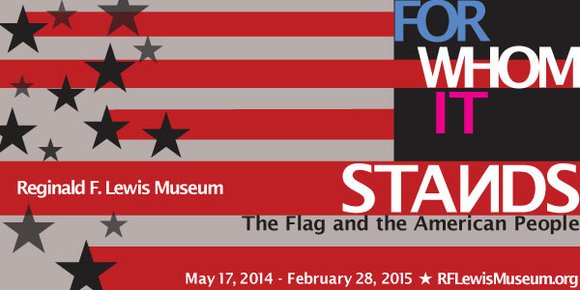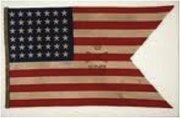BALTIMORE — Awarded Best Historical Exhibition 2014 by Baltimore Magazine, the exhibition For Whom It Stands: The Flag and the American People, relaunches September 10, 2014 with newly added objects that represent iconic moments in U.S. history. A remarkably well-preserved parade flag of the ‘Buffalo Soldiers’ from the 1880s is among the objects. “For Whom It Stands seeks to tell the stories of the flag with a wide-angled perspective in which we all can see ourselves reflected in the national fabric,” says the exhibition’s curator, Dr. Michelle Joan Wilkinson. For Whom It Stands is on view through February 28, 2015 at the Reginald F. Lewis Museum, 830 E. Pratt Street, in Baltimore, Maryland.
(Courtesy Photo)
Cavalry Buffalo Soldiers Parade Flag, ca. 1889. Courtesy of the collection of Bernard and Shirley Kinsey
An original parade flag carried by the 9th Cavalry Buffalo Soldiers Regiment survives as a fascinating piece of U.S. history. “This flag, which is remarkably well-preserved, is an emblematic example of revered figures in African American, and American, history,” says Associate Curator Asantewa Boakyewa. The “Buffalo Soldiers” were the country’s first all-black military units. Established by Congress, the regiments served with distinction from 1868 through World War II. The flag comes on loan from The Kinsey Collection.
Other notable items include a painting that hung in President Lyndon B. Johnson’s bedroom. “Untitled painting of a black woman sewing an American flag” by O. Vereisky was kept close by the president as he presided over the era of the Civil Rights Movement.
For Whom It Stands features more than 100 works of art, artifacts, documents, and photographs that reflect the breadth of American experiences. USA Today has named it one of ten “must-see” exhibitions in the country. Visitors can see a fragment of the original Star-Spangled Banner made during the War of 1812, a photograph of the Navajo code talkers who communicated the message to soldiers to raise the U.S. flag at the Battle of Iwo Jima, and paintings made by an Arab American in response to the September 11 World Trade Center attacks. The exhibition also includes a stellar lineup of African American artists who have used flag motifs, from William H. Johnson and Faith Ringgold to Kerry James Marshall and Sonya Clark. The exhibition is inspired by Grace Wisher, the 13-year-old African American girl who contributed to the creation of the Star-Spangled Banner as an indentured servant in Mary Pickersgill’s household. View images from the exhibition.
Opening Events during Star Spangled Spectacular, September 13-14, 2014
O Say Can You Feel: Stories Inspired by National Flags September 13, 2014, 2pm
Hear from a former neighbor of Emmett Till’s killers. Listen to a modern-day African American relation to Thomas Jefferson. These true stories, told by the people who lived them, weaves original music, poetry, movement and song throughout. This powerful program of oral histories stirs us to reflect on our own relationship to our flag, our country, and to each other. The director is Harriet Lynn of Heritage Theatre Artists’ Consortium.
National Anthem Remix September 14, 2014 5 pm doors, 5:30 performance
In celebration of the 200th anniversary of the National Anthem, renowned beat box artist Shodekeh performs a new interpretation of the National Anthem using virtuoso vocal percussion. His collaborators are the Baltimore Boom Bap Society, a group that performs improvised hip hop; Classical Revolution, a collection of classically-trained musicians who perform classical music in unexpected places; and Embody, a series of the vocal arts. Shodekeh has been featured in The New York Times and the Washington Post.
For Whom It Stands features more than 100 works of art, artifacts, documents, and photographs that reflect the breadth of American experiences. USA Today has named it one of ten “must-see” exhibitions in the country. Visitors can see a fragment of the original Star-Spangled Banner made during the War of 1812, a photograph of the Navajo code talkers who communicated the message to soldiers to raise the U.S. flag at the Battle of Iwo Jima, and paintings made by an Arab American in response to the September 11 World Trade Center attacks. The exhibition also includes a stellar lineup of African American artists who have used flag motifs, from William H. Johnson and Faith Ringgold to Kerry James Marshall and Sonya Clark. The exhibition is inspired by Grace Wisher, the 13-year old African American girl who contributed to the creation of the Star-Spangled Banner as an indentured servant in Mary Pickersgill’s household. View and download hi-res images of the show. View images from the exhibition.

